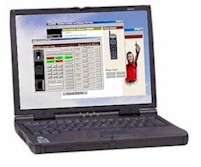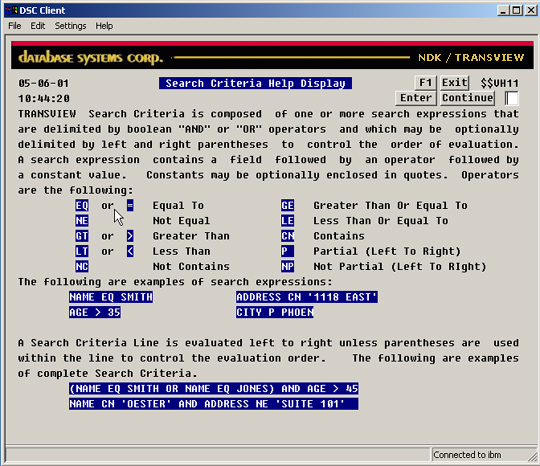|
|
DSC Tech Library
Application Development Toolkit Software
 This section of our technical library presents information and documentation relating to Application Development software and products.
To develop new or upgrade legacy applications for today’s network environments, the NDK components TRANSACT, FASTPlus, EZTRAN, and THIN CLIENT are required as a minimum.
A copy of the THIN CLIENT is required for each PC accessing the final application. The NDK / Server software component can reside on UNIX, LINUX, or a Windows/NT server.
This section of our technical library presents information and documentation relating to Application Development software and products.
To develop new or upgrade legacy applications for today’s network environments, the NDK components TRANSACT, FASTPlus, EZTRAN, and THIN CLIENT are required as a minimum.
A copy of the THIN CLIENT is required for each PC accessing the final application. The NDK / Server software component can reside on UNIX, LINUX, or a Windows/NT server.
TRANSVIEW - Database Query System
Although
TRANSVIEW can significantly reduce application development time, this NDK
component is directed at both the user of the final application, as well
as the developer. For the developer, it provides a tool to propagate a
test database quickly, recreate the test database easily, verify data in
files have been updated properly, and a variety of other useful tasks to
help expedite application development. However, TRANSVIEW also provides a
powerful AD HOC capability for the users of the final application (if user
is given full or partial access to this component’s features). The ADHOC
user data can also use TRANSWRITER’S displays or reports previously
defined.

- Easy to use, interactive language.
- Menu-driven responses with descriptive prompting.
- Fully integrated HELP system.
- Relational-like file linking, including relating different file types.
- Complete file update capabilities, including Add, Change, and Delete.
- Powerful file transfer, including reformatting of data.
- Complex Boolean data search expressions, including linked file search.
- Flexible merge function linking to word processing documents.
- Sort capability, including related file reordering.
- Global compute and update feature, including linked file updates.
- Security access control, including file and command restrictions.
- Standard report writing capability.
- Program interface allows TRANSVIEW to be invoked from any application program.
Database Maintenance
Data
management begins with data files. TRANSVIEW lets developers create,
modify, and delete data files. File relationships, or links, can be easily
defined which let developers relate two files through a common field.
These links provide developers with a much broader access of data than
with a single file system. Once these links have been described,
developers may access many files at one time, including different file
types. Thus records can be accessed, sorted, changed, and printed using
several files at one time.
Data Search Capability
To
access a TRANSVIEW file, users must first select it. Additional related
files may likewise be selected. To locate records within a database, use
the FIND command. Powerful search relationships may be used within this
command, including Boolean operations. This command locates records in all
related files; therefore, the search criteria can be from any file users
select. Once the proper records requested have been located, they are
stored in a “set”. Users can create multiple sets at the same time.
Data queries use search expressions stated in simple language terms.
These
expressions can be combined using Boolean “AND” and “OR”
operators, parenthesized for compound conditions. All relational
operations, as well as inclusion, are valid in a search expression. Data
Access and Manipulation.
TRANSVIEW
provides users with a variety of file access and update commands. Users
can perform all of these functions from a screen by simply filling in the
blanks. Once a record has been located, it is displayed on the screen and
users may change or delete this record, or simply display the next record
that meets the search criteria. Users can also perform global updates,
computations, and deletions through very simple commands. Multiple files
can be accessed and updated using these functions. TRANSVIEW presents
users with a single screen for command input and prompts users to enter a
TRANSVIEW command. Commands can be entered on this screen in free form.
If a
command requires additional information prior to execution, TRANSVIEW will
prompt users with an additional self-explanatory screen. By simply
depressing a function key, a complete HELP system is available describing
the operation of TRANSVIEW and each of its commands.
|


 This section of our technical library presents information and documentation relating to Application Development software and products.
To develop new or upgrade legacy applications for today’s network environments, the NDK components TRANSACT, FASTPlus, EZTRAN, and THIN CLIENT are required as a minimum.
A copy of the THIN CLIENT is required for each PC accessing the final application. The NDK / Server software component can reside on UNIX, LINUX, or a Windows/NT server.
This section of our technical library presents information and documentation relating to Application Development software and products.
To develop new or upgrade legacy applications for today’s network environments, the NDK components TRANSACT, FASTPlus, EZTRAN, and THIN CLIENT are required as a minimum.
A copy of the THIN CLIENT is required for each PC accessing the final application. The NDK / Server software component can reside on UNIX, LINUX, or a Windows/NT server.
